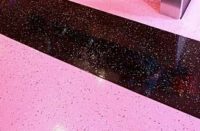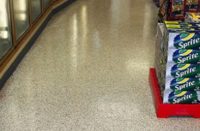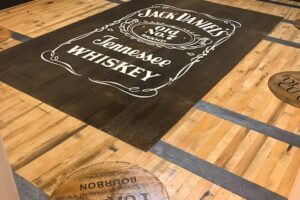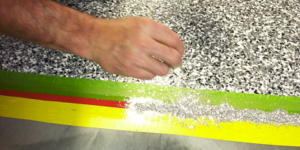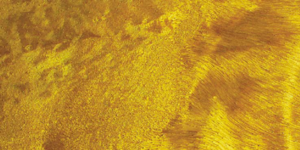First came the revolution.
The decorative concrete wave swept the concrete construction trade not so long ago, churning up myriad visual concepts and the materials that made them happen. As the wave receded, decorative concrete concepts, methods and materials entered an evolutionary phase. Some faded from the scene, others were refined or improved. New ideas emerged.
Today, the evolution continues as suppliers tweak performance properties, introduce stunning new visuals, and work to maximize application efficiency in materials for architectural and decorative concrete. In this report, we’ll look at coatings, and review a sampling of recent developments and emerging materials.
Defense mechanism
Decorative and protective concrete treatments are called on to serve multiple purposes. They must be attractive and resistant to water, chemicals, contaminants, UV rays, impact and/or abrasion. For health care facilities, add antimicrobial features to the list.
Laticrete International enlisted the antimicrobial action of silver ion in its high-performance polyaspartic coating system, Spartacote Clinical Plus. This coating combines a decorative chip flooring material with a polyaspartic topcoat that incorporates silver ion technology to “minimize and mitigate” microbial growth on the coating surface, says Jeff Bonkiewicz, Laticrete channel manager. “This is a low-odor, very low-VOC concrete coating system,” with a wide range of standard and custom colors and several decorative-chip systems.
The topcoat locks in the chip materials — quartz, vinyl and mica — while delivering the high-performance properties of polyaspartics — abrasion, impact and chemical resistance.
The system also offers polyaspartics’ accelerated cure characteristic for fast turnaround, Bonkiewicz says, an important trait for health care facilities. The surface can accommodate foot traffic in just two hours, and vehicle traffic in 24 hours, he says.
Another feature of the system — odor mitigation — makes it a candidate for bathrooms, locker rooms and shower areas, on both horizontal and vertical surfaces. Schools and other institutional facilities where “ultimate cleanliness is imperative” also are likely markets for the technology, Bonkiewicz says.
Outside of health care and animal care settings, Bonkiewicz says the coating system is a high-performance alternative to concrete polishing where the surface isn’t suitable for polishing.
To install the system, the surface must be cleaned and prepped with a mechanical profile. Then apply the pigmented polyaspartic basecoat, chip broadcast into the wet basecoat, let cure (only about two hours), scrape to remove excess chips and apply the clear polyaspartic topcoat.
Bonkiewicz says the system offers contractors the potential for significant profitability and portfolio diversification, thanks to its performance prowess, accelerated cure time and the antimicrobial feature. “It’s an insurance policy for owners against bacteria and microbial growth,” he says.
The 3-D effect
Ultrafine metallic pigments in SureCrete’s decorative epoxy flooring systems are billed as producing a 3-D effect. The effect is generating significant buzz, says Tony Leff, SureCrete vice president of marketing. The Dura-Kote metallic epoxy overlay system employs metallic pigments to create “organic” effects. Organic, in the sense that the colors and effects produce unanticipated results.
When the overlay is initially placed, “it almost shimmers at the top,” Leff says. Then it thickens, and the ultrafine metallic pigment migrates, settling to produce a 3-D effect. That’s the organic part — color can be concentrated in a certain area, but there’s no certainty as to its movement and eventual visual result.
This customized, high-impact flooring system has gained admirers in the last two to three years, Leff says.
Metallic epoxy flooring “is all about light,” SureCrete notes. The surface reflects light to generate “an overall increase in energy” and the floor “expands the amount and quality of light in the room.”
SureCrete points to some 8.7 million YouTube views — and counting — of a video, “Put a Little Metallic in Your Life Step By Step (www.surecretedesign.com/2017-flooring-trend),” that captures visual effects produced with the epoxy overlays.
The system comprises a primer, metallic color coat and clear topcoat. The pigments, DK Metallics, are added to the two-component color coat, which is spread onto the primed surface using a rake or notched squeegee and rollers. A small roller can be used to create swirls. You need to screen the primer and metallic coats to ensure a bond between coats and to remove any dirt or debris, followed by vacuuming and wiping with denatured alcohol or acetone. Finish things off with a topcoat of one of the recommended polyurethanes or polyaspartics.
Metallic epoxy overlays lend themselves to a wide range of commercial settings, including retail stores, offices, bars, restaurants and residential – particularly garages, man caves and bathrooms.
Also beginning to gain market traction, Leff says, is an overlay system that delivers a faux-wood surface that looks like a hardwood floor but has the durability and minimum upkeep of concrete. Interest in the faux-wood concrete overlay is far from peaking, he says, as few consumers are familiar with it.
Hitting the accelerator
Return-to-service speed is paramount these days, and Endurable Concrete Products is capitalizing on this need for speed, says Brian Hudgens, global operations director. Expect a fast turnaround with Endurable Concrete Sealer, a modified polyurethane that’s highly UV stable and low in VOCs and odor. The company says the environmentally friendly sealer is breathable (allows water-vapor transmission), a key property for coatings applied to concrete.
Hudgens says the combination of this sealer and the company’s stains is clicking among contractors, as demand for restoration of aging decorative concrete installations escalates.
Simplicity is the key: Hudgens says Endurable set out to develop a waterborne sealer that uses standard sprayers, with a single formula for all applications, in interior or exterior projects.
Combined with the company’s Endurable Concrete Stains, the sealer can be applied on the heels of staining, Hudgens says, “within seconds” in the case of an acetone stain mix, and not much more than that with a water-based stain, depending on conditions.
* The story that ran in the printed October issue included less specific information on Endurable Concrete Products’ Endurable Concrete Sealer. The online version contains more detailed information
Surface prep typically involves removing oils or other contaminants, residual sealers, coatings or release agents — anything that could impede the chemical bond. Endurable suggests using its Power Stripper and a power wash to remove sealers or coatings. “Once the surface is dry, you can apply the stain and sealer,” Hudgens says. “No 48-hour wait.”
Hudgens cites a recent project in Louisiana as an example of the stain-and-seal system’s application. Here, the aging green color of stamped sidewalks in a busy commercial district dictated a total do-over using a nonfilm-forming color system. Initially thinking he’d have to demolish the stamped surface, the owner was advised of the stain-seal alternative. The cost and time reduction were substantial, says contractor Steve Malone, owner of Custom Concrete Designs of New Orleans.
The project, in a district sometimes called “Fat City” in Jefferson Parish near New Orleans, would put any coating system to test with all its traffic.
Malone used Endurable’s Power Stripper and power wash to remove residual coating and sealer. Then he applied two coats of a gray Storm Cloud stain and added a black accent with Obsidian. “It was being absorbed as fast as I was putting it down,” he says. “By the time I started to mix up the sealer, it was time to apply.”
Malone and a crew of two other workers stained and sealed 5,000 square feet a day. The speed of application, dry and return to service — and early resistance properties — impressed Malone. “It went down so fast and traffic was able to get on it so quickly,” he says.
This recent project can’t prove long-term durability, Malone says, but he could take a sharp object and scratch the surface and you wouldn’t see a thing.
Communication tool connects coatings and concrete
Sustainability and “green” issues permeate the construction industry, and materials specification for LEED credits is a major focus of a new Flowcrete blog site, says Megan Jasin, marketing manager for Flowcrete Americas. Case in point: A recent AllThingsFlooring post, “Car Parking Solutions that Gain LEED points,” by Will Facer, Flowcrete marketing manager, Asia-Pacific.
“Car parking” or “car park” translates to “parking garage” in American, but LEED and green building are global in reach. In the blog post, Facer discusses how specifications aimed at earning LEED credits span the car-park project from end to end and top to bottom, starting with design and layout down to the parking bays and choice of line marking.
In the category of LEED credits for coatings, Flowcrete references its Deckshield car-park protection systems, designed to meet “contemporary requirements for upmarket car-park environments” — visual appearance, enhanced light reflectivity, reduction of noise from tire squeal and promotion of safety.
Recent advances in its parking-deck coatings, Jasin says, include accelerated cure rates aimed at optimizing that coveted “return to service.”
Jasin emphasizes that the All Things Flooring site isn’t just a Flowcrete promotional vehicle — its content focuses on marketplace realities. The varied perspectives are provided by “business-to-business decision makers involved in the specification and installation of flooring materials in industrial facilities and commercial venues.”
www.allthingsflooring.com
No concrete floor? No problem!
You’re sold on the look and performance of decorative concrete floors, but you’re missing one key component: The concrete!
No concrete? No problem.
That’s the message Westcoat Specialty Coating Systems and the company’s product manager, Todd Cook, are conveying about the Westcoat ALX Interior system. The cementitious overlay system can convert a floor covered with carpet, tile or some other product to a concrete surface.
The ALX system has been around for some time, but Cook says Westcoat is working to get the word out that a concrete floor can be an option where concrete is not the existing floor-construction material. And it’s an option for more than the ground floor, Cook adds.
The system addresses the question: “How do I get the look of concrete without the concrete substrate?” Cook says.

ALX Interior is a package deal — hardware, sheet membrane, metal lath, cementitious materials, stain and colorants. As with any overlay system, the substrate must be solid, clean and free of existing coatings or contaminants. A plywood floor is required — OSB is not compatible. Plywood thickness should be at least 3/4 inch, with a supporting joist span of 16 inches. Additional blocking (installing a reinforcing framing member) may be needed to firm up the substrate.
“We’re looking for a more robust substrate,” Cook says. “We don’t want deflection that would cause cracking in the (cementitious) substrate.” He says this solid substrate, plus thorough surface cleaning, is crucial to the system’s success.
“There are all kinds of options for projects,” Cook says. Different colors can be applied simultaneously to create a variegated look, two or three colors can create an acid-stained look or one color can be manipulated for special effects. Patterns and stencils are other options, as is Westcoat’s Liquid Dazzle metallic coating.
Cook says Westcoat has continued to revise and reformulate the ALX system’s components, introducing environmentally compliant coatings such as 100 percent solids epoxy and low-VOC, low-odor polyurethanes.
“These will allow a facility to stay open, which is a major plus along with nonflammability,” he says, noting that “shutting everything down,” including all pilot lights, is frequently not an option. He adds that the system is formulated for environmental compliance nationwide, from Southern California to the Northeast.

Decorative concrete floors continue to gain momentum in the marketplace, as designers increasingly specify these systems and owners want to know more after seeing examples in homes, offices and retail outlets.
“We’ll do ‘lunch and learns,’ and talk about this, and architects will say ‘Wow I didn’t know that was an option,’” Cook says of the ALX Interior system as applied to plywood floors. “They figured tile and carpet were their only options.”
www.westcoat.com
New horizons, new chemistries
At Excalibur Flooring & Surface Artisans, new market opportunities and new chemistries are extending the horizons for high-performance polyaspartic and polyurethane coatings.
The high-performance profile of polyaspartic coatings — warp-speed cure, hardness and durability — offers intriguing possibilities for countertop and even furniture finishes, says Darryl Bates, president.
Also new to the market is a polyurethane topcoat with a nonslip additive. “Usually a nonslip additive takes much away from the depth of a nice metallic epoxy,” Bates says. “Our new version does not.”
One formulation, Excalibur 321-100, exhibits a light texture and satin finish. Another, 321-200, retains a higher gloss level, with a tacky feel that provides slip resistance without the use of additives or texture, Bates says.
Also inching closer to commercialization is a decorative textured wall finish with metallic effects, Bates says. Excalibur operates from locations in Monroe, Wisconsin, and Las Vegas.


Stretching polyaspartics’ properties
The application, performance and aesthetic qualities of polyaspartic coatings for concrete are well documented, with their speedy cure and return-to-service benefits. Covestro, a major developer of polyaspartic chemistries, notes a recent scientific advance has now enhanced the cured coating’s elongation or “stretch” properties.
This advance, says Covestro’s Steven Reinstadtler, means polyaspartics can now be used where a more flexible coating is needed, such as balconies, terraces or other concrete floors that may have some movement.
Reinstadtler, Covestro market manager of construction coatings, adhesives and specialties, says the hard, tough surface provided by polyaspartic coatings for scratch and mar resistance typically comes with low film flexibility. Plasticizers used to enhance elongation typically reduce abrasion, scratch and tear resistance. Plasticizers also can “migrate out” over time, causing the film to become brittle and prone to cracking during substrate movement. Adding high-viscosity hardeners to offset these drawbacks could require more solvent to reduce viscosity.
Looking to enhance coating-film flexibility, Covestro developed a low-viscosity aliphatic hardener that can boost flexibility without adding a plasticizer or compromising polyaspartic performance properties. Combined with a polyaspartic resin, the hardener allows formulation of a coating with cured-film elongation of 50-350 percent.
The coatings formulator can produce “a flexible polyaspartic system with ultra-low VOC and odor, low viscosity and extended working time to allow it to be used as a self-leveling concrete coating,” Reinstadtler says.
“A more flexible polyaspartic floor coating creates opportunities for several new areas where traditional polyaspartics are not typically used,” Reinstadtler says. “For example, a waterproofing system is often applied to balconies and terraces in multifamily buildings. For a faster return to service, a contractor can apply a flexible, crack-bridging polyaspartic coating as a weather- and color-stable finish over the waterproofing basecoat, which then becomes the top visible layer of the multilayer waterproofing system.”
www.covestro.com
www.excalibursurfaces.com
www.hdipinc.com
www.laticrete.com
www.surecretedesign.com
